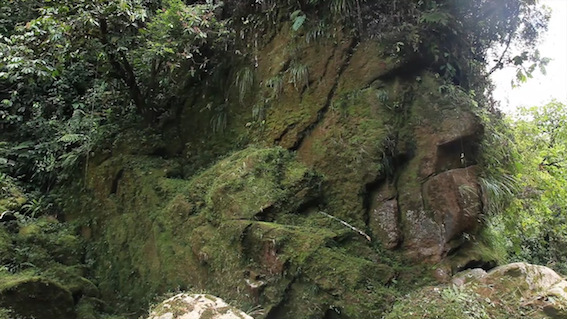
The ""Harakbut Face" in the south-east Peruvian Amazon in a remote part of Harakbut territories. Image: Diego Cortijo
US company Hunt Oil has announced it is suspending exploratory drilling in one of the remotest, most biodiverse parts of Peru's Amazon.
Hunt's operations have been dogged with controversy and fiercely opposed by indigenous organisations representing communities in the region.
Hunt's concession, Lot 76, overlaps a huge swathe of the supposedly protected "Amarakaeri Communal Reserve" (ACR), most of which is indigenous Harakbut territory.
Potential gas deposits in Lot 76, which is located immediately to the east of the world-famous Manu National Park, have been touted as Peru's largest.
Hunt recently built a drilling platform, PAD-A, in the heart of the ACR as part of an exploration phase scheduled to include eight platforms and seismic tests.
Many Harakbuts are particularly concerned about Hunt's drilling because of the proposed platform locations in the headwaters of rivers which they depend on for their survival.
In a letter to the indigenous community-based team running the ACR, known as the ECA, Hunt said they were stopping operations at PAD-A, withdrawing equipment and closing it.
"On 8 May it was decided to suspend perforation activities at Platform A," reads the letter written by Hunt's Silvana Lay to Fermin Chimatani, a Harakbut man and ECA's president.
"For us the suspension is a joy that means perforation activities won't advance and will reduce or stop the current and potential socio-environmental impacts," says Chimatani.
Tom Bewick, from the Rainforest Foundation US, believes it is possible the decision to suspend operations at PAD-A may mean Hunt will withdraw from Lot 76 altogether.
"My sources tell me that Hunt didn't find what they were looking for, and they might scrap the entire program, deciding it's not worth the investment," Bewick says. "This might be it."
Hunt's letter, dated 21 May, is vague about the reasons for its decision, saying the "results of perforation weren't what were hoped for."
The letter is also vague about future operations, saying Hunt will "analyse the information obtained during perforation, which will orient [our] next actions."
According to a 4 June statement by indigenous organization FENAMAD, Hunt's Luis Angel Yallico Magde recently said the withdrawal process from PAD-A has begun.
"Yallico said the company isn't abandoning Lot 76, only [PAD-A] where they had drilled a well 3,070 metres deep and the results weren't what they hoped," FENAMAD states.
"Perupetro representative Santiago Armas confirmed Hunt Oil didn't find hydrocarbons at Platform A and the company is now abandoning it," FENAMAD's statement continues.
In a second FENAMAD statement issued the same day, Chimatani urges the government to ensure that Hunt's withdrawal from PAD-A is properly monitored.
The statement also cites Ricardo Segovia, from consultancy E-Tech International, saying the withdrawal must happen as quickly as possible in order to minimise environmental damage.
"Hunt must comply with its "Cessation Plan" to clear the area up, and ECA and SERNANP [the government body co-running the ACR] need to monitor that it complies," says Bewick.
FENAMAD has been fiercely opposed to Hunt's operations in Lot 76, filing two lawsuits to stop the company and making frequent public statements against it.
FENAMAD, together with ECA and local indigenous organisation COHARYIMA have also been hoping the recent "rediscovery" of an extraordinary rock-face might stop Hunt.
The rock-face, known as the "Harakbut Face", is in one of the most inaccessible parts of the ACR and is extremely important culturally and spiritually to many Harakbuts.
According to FENAMAD and other Harakbut leaders, neither the government nor Hunt considered the impacts of drilling on the "Harakbut Face" and other archaeological remains.
The ACR was created in 2002 to protect Harakbut and other indigenous territories, rivers and "great biological diversity", but Lot 76 was superimposed over it three years later.
Hunt did not respond to questions.